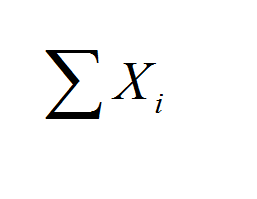Sum Calculator
Instructions: Use this sum calculator to compute any valid expression involving sums that you provide, showing all the steps. Please type in the fraction calculation you want to carry out in the form box below.
More about this sum calculator
This calculator will allow you to compute and simplify expressions that involve sums of the most common Algebra objects, such as numbers, fractions, radicals and common functions, showing all the steps. You need to provide a valid expression that involves sums/additions. For example, it could be something simple like '3/4 + 1/3', or something more complex like 'sqrt(1/3+1/4)+(1/8+1/6)'.
Once you have provided a valid numeric expression, just click on "Calculate", and our calculator will show you all the steps.
Doing sums of basic algebra terms can seem simple, and it is fairly simple, it just gets laborious and error prone when you need to work on a long and convoluted term.

How to add expressions?
Adding simpler expressions together is simple, and you have two powerful tools at your avail: the rules of associativity and commutativity.
In layman terms, associativity says that when you are adding terms, parentheses can be removed safely, and the result won't change. Also, commutativity means that you can change the order of a sum and the outcome won't change.
What are the steps for adding expression?
- Step 1: Identify the expression you want to simplify, and identify the part that consists only of sums and can be isolated
- Step 2: Using the associative rule, you can remove parentheses wherever only sums are involved
- Step 3: Conduct the addition term by term, and you can switch the order of the operands if useful
- Step 4: The rules above applies for expressions that consist of multiplications only too, but not necessarily when you mix them up
These rules don't work with subtractions or divisions. This is, when you have subtractions you cannot simply remove parentheses, because the outcome can indeed change. Indeed, for example if you have \(1-(3-1)\) which is correctly simplified as \(1-(3-1) = 1 - 2 = -1 \), which is not the same as what you get when just removing the parentheses: \(1-3-1\) which simplifies to -3, so the outcome changes.
How to add expressions?
The idea is to group terms that are similar: among the terms you are adding, you can group together numbers, fractions, and then operate them.
The idea is to go operating terms that are easily to operate together, like numbers and fractions. Then, if you have more complex, compounded expression, you work from inside to outside, but looking at easy operations first.
The main care you need to take is when you have parentheses, noticing that they cannot be simply removed if you have a mix of operations. Associative property works only when there is no mixing of different operations.
Why is it useful to add expressions?
Adding simple expressions is one of the most basic operations that you can conduct, and it is a cornerstone in any math operation, period.
It is truly impossible to overstate the importance of correctly adding fractions, and correctly simplifying expressions by grouping and using the correct operation order.

Example: Calculating the sum of expressions
Calculate the following: \(\frac{1}{3} + \left(\frac{6}{4} - \frac{5}{6}\right)\)
Solution: We need to calculate and simplify the following expression: \(\displaystyle \frac{1}{3}+\left(\frac{6}{4}-\frac{5}{6}\right)\).
The following calculation is obtained:
Example: Calculating the sum of expression
Calculate the following: \(2 + \frac{5}{4} - \frac{7}{6}\)
Solution: We need to calculate and simplify the following expression: \(\displaystyle 2+\frac{5}{4}-\frac{7}{6}\).
The following calculation is obtained:
which concludes the calculation.
Example: Another addition calculation
Calculate \( \left(\frac{4}{3} \times \frac{6}{5} \right)+ \frac{1}{5} \).
Solution: We need to calculate and simplify the following expression: \(\displaystyle \left(\frac{4}{3}\cdot\frac{6}{5}\right)+\frac{1}{5}\).
The following calculation is obtained:
which concludes the calculation.
Other useful algebra calculators
Additions are the most fundamental operations you can conduct. You can also use a fraction calculator to do additions of fractions specifically.
Also, when working with fractions there is a special case that deals with terms like '1 1/2', for which you can use a mixed fraction calculator


